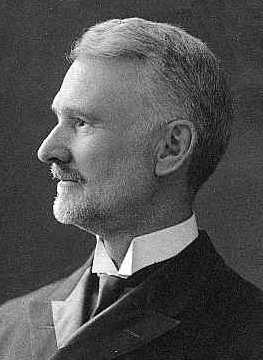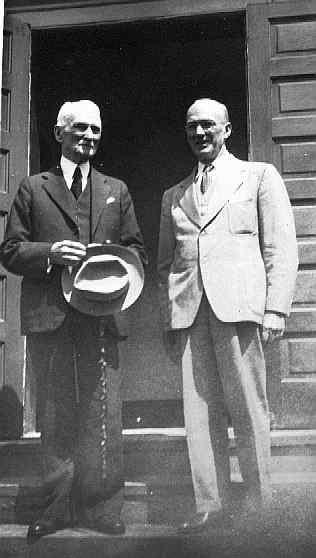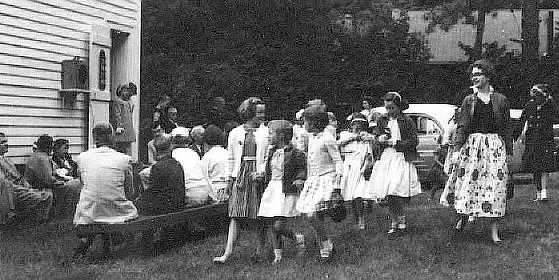The Stewart Memorial Church: We are often troubled, but never crushed;
During the 1870s, a number of families who had moved from Grey County, south of Owen Sound, to the area around Dwight, began to feel the need of pastoral care. Having known the Reverend Alexander Stewart in Durham, they wrote asking him to come to Dwight, and short visits beginning in the late 1870's extended by 1883 into a series of annual visits - spring through fall - whose result was the organization of the Baptist church and the construction of the building standing beside the Lake of Bays to this day. When he arrived in Dwight, Pastor Stewart was 70 years old, having emigrated to Canada in 1832, many years before. Born to lowly circumstances in Scotland, he worked in his new country in warehouses and sawmills, married, and entered the Baptist ministry as a missionary among settlers and Indians. Sturdy, well-met, and courageous, he was a true man of the frontier. In the early days in Durham, he had owned a horse and wagon, but sold the horse for a small plot of ground and the wagon to pay for carpenter work on his house. For eight years in Durham, he journeyed on foot, getting up Sunday mornings to walk sixteen miles to Mount Forest, regularly, for eleven o'clock service. It was nothing for him to start walking on Saturday evening, after the children were in bed, and to cover twenty or twenty-five miles. Fondly remembered, he was recalled by his grandsons as "a stocky little man who loved to take part in pillow fights and to rough-house in our bedroom."
On Sunday, August 21 of 1887, the first service was held in the newly-built sanctuary, with three preachers to honour the opening day: the Reverend A. Grant, Missionary Superintendent; the Reverend J. W. A. Stewart, son of the founder and minister of the First Baptist Church of Rochester; and the Reverend D. Hutchenson of Brantford. On the following day, a tea meeting was held, with addresses and a supper, a special steamboat excursion being run by Captain Marsh to bring people from as far away as Baysville and Colebridge, now Dorset. The fare was forty cents. On May 22, 1888, Nellie Hayman and Sam Wells were the first couple to be married in the new church. After the church was established, student ministers were sent by the Home Missionary Society for the summer session, but as the Rev. J. W. A. Stewart had made Dwight his summer home, he was available to preach during vacation, with the result that the sending of students ceased. For the next fifty years, Dr. Stewart was the church's summer preacher.
J. W. A. Stewart, one of many second-generation Canadians who received excellent educations here and then went on to make their marks in the United States, was unique in his educational career. After elementary school, he was tutored by the town's Presbyterian minister, in exchange for doing chores, so that he could enter the Canadian Literary Institute at Woodstock, Ontario. He later attended the University of Toronto and Woodstock again in its theology department. After his graduation, his career in the ministry led to the position of Dean of the Rochester Theological Seminary (later Colgate-Rochester) in Rochester, New York. In the early years at Dwight, J. W. A. would march into the pulpit wearing his Prince Albert coat, a stiffly starched shirt, and a wing collar, while the congregation - mostly settlers whose rough clothes were all their backwoods homes could afford - sat patiently on rows of simple wooden benches. After a few years, the frock coat disappeared, but what remained was the aura of the Victorian Age. In those early days, when most of the settlers arrived by boat, the steamboat would make an excursion to Dwight for special services, but always, from far back in the woods, men and women walked miles and miles to attend church. Over the years, as the church evolved into a vacationers' church, more of the sermons were intellectual, reflecting the great debates of the late 19th and early 20th centuries - about science and religion, and about the impact of higher criticism in theological circles. Never failing to be stimulated, J. W. A. continued to believe that science and religion could be reconciled, and to teach that Biblical scholarship, rather than a challenge to faith, was a strong support. As a result of a summer trip to Europe, during his long pastorate at Dwight, J. W. A. would bring to his remarks - about the magnificence of God's creation - descriptions of the lakes of Italy and the mountains of Switzerland. Invariably, at the conclusion, however, he would comment with deep feeling that the Lake of Bays was more beautiful than anything he had seen abroad. On occasion, J. W. A. brought to the pulpit men of considerable talent, such as Chancellor Whidden of McMaster University and Professor Walter Rauschenbusch[1] of the Colgate Rochester Theological Seminary. Of Prof. Rauschenbusch, one learned commentator said that "no serious history of the United States can neglect the impact of this man on religious and social thought at the turn of the century." From its inception, the Baptist church was primarily a summer congregation, while St. Peter's church met the community's need for regular services throughout the year. In time, St. Peter's church developed a steady membership and a Sunday School. The plot of land on which St. Peter's church eventually would stand - just west of the Gouldie House on Dwight Bay Road - had been given by Ed Gouldie. In 1889, the men of the church built the sanctuary, while the women, organized by Mrs. Janet Gouldie, Ed's wife, made the noonday meals - a typical frontier bee. In a town which depended on both summer visitors and settlers, the two churches complemented and helped one another. In fact, early-arriving and later-staying vacationers attended the Presbyterian church if the Baptist church was closed, and Presbyterian members who knew and admired J. W. A. would attend his services from time to time in the summer. A sister-in-law of J. W. A., Caroline Quinby, taught at St. Peter's in the afternoon Sunday School, after attending the Baptist morning service. Now and then, union services were held, with three clergymen participating: the young seminarian from St. Peter's; J. W. A. from the Baptist church, and old Mr. Pratt, a watchmaker from England who was a local exhorter of the Methodist church. Invariably, in this early ecumenical experiment, it was Mr. Pratt who pronounced the benediction. During the early years, when hymn singing, solos, duets and quartets enlivened the services, both churches acquired reed organs. Mary, the wife of J. W. A.[photo], as well as several of their children, played the organ, and the boys were good singers. In time, however, three splendid musicians entered Dwight life: Joseph Tapley [photo], a renowned star of the London, England light opera stage, moved, at the turn of the century, to a property at the head of Haystack Bay, and for years thereafter he occasionally played the organ and sang, with great gusto and style, in unforgettable performances. The other two stars, Douglas and Dora Atkinson, had met at Dwight, her cousin having been the Presbyterian clergyman in the late 1890s. During their early years at Dwight, a fascinating boathouse beside the town dock was their summer home. For many years the soprano soloist at Jarvis Street Baptist Church in Toronto, with the great Dr. Vogt, Dora Atkinson had had professional training in voice and piano, while Douglas, an accomplished organist and teacher, was also an organ designer.
When the Atkinsons moved from the boathouse, their new home to the west of the church became the centre of Dwight's summer musical life. To make possible the kind of musical evenings they loved, their organ and piano were tuned together. Outgoing and hospitable, they not only performed at home and in church, but they cultivated all persons interested in music, among them Florence Boothby, who assisted Douglas, and who later, after his retirement, continued until 1967 as church organist. During the many years of Douglas Atkinson's organ playing at the St. Peter's church, people made a habit of arriving early to listen to the marvellous improvisations, but not everyone was enchanted by music: one devout Scots Presbyterian refused to set foot in St. Peter's because of its "barrel of wussels." After fifty years in the pulpit of the Baptist church, when J. W. A. gave up his active Dwight ministry, he felt the time had come for the church's future to be established. Because many of the Baptists had died or moved away, and there were no more Baptist recruits, he looked toward the newly-formed United Church, of which St. Peter's had become a part. Now in existence was a larger parish, called the Muskoka United Charge, with a settled group of ministers. By placing the building in the hands of the United Charge, and giving it to the members of St. Peter's, J. W. A. found a wise way of ensuring the perpetuation of the church's unique summer mission. Almost the sole surviving member of the earlier church, Mr. Fred Emberson, was persuaded of the wisdom of the move by J. W. A., and, at a meeting on September 20, 1936, attended by the two congregations, the property was transferred. At this meeting, Mrs. Archie Gouldie suggested that the church be named the Stewart Memorial Church in honour of its founder, the Reverend Alexander Stewart. From earliest times, the summer ministers accepted no pay, leaving the collections in the churches to be used for upkeep of buildings or for the community. After the merger with St. Peter's, monies not needed for maintenance of the Stewart Church or for St. Peter's were turned over to the local Charge. In the thirty years following the merger, St. Peter's continued as the winter church, with Stewart Memorial serving the summer community. At first, a son of J. W. A., the Reverend Harold Stewart,[2] conducted the summer services; but unlike his father, he shared the pulpit with numerous ministers and scholars who vacationed on or near the lake. Passing of the torch: The Rev. J.W.A.
Stewart, in his 90s, More photos from the same Sunday
In 1961, when he became principal minister, the Reverend Paul Stirling[3] continued this practice, and as a result, the Dwight summer congregations were able to hear some of the best preaching of the time. Old Testament stories re-told as only a Mississippian - Principal Nathaniel Parker, of the McMaster Divinity School - could tell them; clarity and logic of exposition that were the special mark of the Reverend Robert James McCracken of Riverside Church in New York; and the low-key, sometimes witty sermons of the Reverend Paul Stirling, of St. George's Church in Toronto; also a special summer attraction was the dramatic preaching of the Reverend Minton Johnson to which the church's congregation eagerly looked forward. Indeed, each summer brought a new mix of preachers and scholars, some of whom returned year after year. A few names that stand out include: the Reverend Professor Frederick W. Waters; the Reverend Professor Russell Aldwinkle; the Reverend John Robson; the Reverend Graham Tipple; the Right Reverend Ernest M. House, a Moderator of the United Church of Canada; the Reverend Robert Lennox; the Reverend R. F. Rice; the Reverend Charles Hay; the Reverend S. W. Vance; the Reverend R. A. G. Passmore; the Reverend Professor A. L. Farris; the Reverend James D. C. Jack. In contrast to the boats and wagons of the early days, the automobile made possible the recruitment of preachers from "Presbyterian Row" on Ten Mile Bay, as well as from beyond Dorset and other distant places. Also provided by the many automobiles was a much wider base for summer congregations; this meant that during the 1950s a public address system was installed at the Stewart Church, permitting those unable to find seats in the church to hear the service while basking in the sun or in their cars. Children leaving for Sunday School during a service in the late 1950's. Note also the loudspeaker and hymn board at the rear door,
Toward the end of 1953, two great granddaughers-in-law of Alexander Stewart, Dorothy Stewart and Madeline Welch suggested that a Sunday School be organized to care for the ever-growing group of children attending church with their parents. Before the sermon each Sunday, the children would leave to have their program on the lawn, or, when the weather indicated, either on the verandah of the Harold Stewart cottage to the east of the church or indoors by the fire. After seven years, Meada Richardson took charge of the Sunday School, and, as time passed, one and then another of the women of the congregation assumed responsibility for the children. In 1967-8, the final integration of the two churches began, when St. Peter's was sold, and a Sunday School room - its windows moved from St. Peters' - was added to the back of Stewart Memorial. At first, a distinct difference existed between the summer and winter congregations, but, as time went on, more summer residents began to arrive early in the spring and to stay later in the fall each year. Some, in fact, made Muskoka their year-round home, and the ministers, too, who were assigned to the Charge, occupied the pulpit to an increasing degree throughout the summers. When the Reverend Paul Stirling retired, the leadership rested entirely with the Charge itself, but, as is commonplace in small churches, several of the subsequent ministers moved on after a few years in Dwight. During this phase, continuity and a strong tie to the past were provided by the late Reverend John Braham, who had retired and was living at Cooper's Lake. His unique understanding of the community and of the purpose of the church proved to be invaluable. Today, the permanent residents of the community provide the church with institutional strength and leadership. Unlike the early church, operating when religion reached Dwight in the form of missionary endeavour, today's church has taken root and has become a vital part of the community. The Choir, the Sunday School, the Bible Study Group, and the United Church Women are successful on-going programs, while the work of the Worship and Outreach, the Christian Education, and the Property and Finance Committees of the Session ensure the day-to-day operation of the church. With a sense of mission, the Stewart Memorial Church has entered upon a second century of growth and service. 1) Author of Christianity and the Social Crisis (1907); Christianizing the Social Order (1912); and A Theology of the Social Gospel (1917). 2) The Reverend Harold Stewart, B.A., B.D., D.D., graduate of the University of Rochester, Harvard University, and the Colgate Rochester Divinity School, had been a Baptist minister in Coudersport, Pennsylvania, Oak Park, Illinois, Phildelphia, Pennsylvania and Toledo, Ohio. During the twenty-five years he conducted summer services, he was Dean of Theology , and Dean of Theology Emeritus, at McMaster University in Hamilton, Ontario. 3) The Reverend J. S. Paul Stirling, B. A., B. D., D. D, graduate of the University of Edinburgh, was assistant minister at St. Giles Cathedral, Edinburgh. He was also chaplain to the Mills and Steamers Association in the jute mills on the Hoogli River in India. During World War II, he was on active service with the Baluchistan Light Infantry of the Indian Army, posted in the Middle East. During the years when he was principal minister in Dwight, he was also minister at St. Andrew's Presbyterian Church in Toronto. This short history was written for the church's 100th anniversary celebration by the late Gordon M. Stewart, great-grandson of the founder, mainly from his notes and from the history The Stewarts of Dwight, written by his father, Harold S. Stewart. Production of the centennial pamphlet was by Nancy Vichert. Scanning and captioning of images, and formatting of this digitla version, were by John S. Allen. |
 The Rev.
Alexander Stewart, founder of the church
The Rev.
Alexander Stewart, founder of the church 
 The Rev. J.W.A. Stewart
The Rev. J.W.A. Stewart  G. D. Atkinson playing the church's reed organ, 1950s
G. D. Atkinson playing the church's reed organ, 1950s
